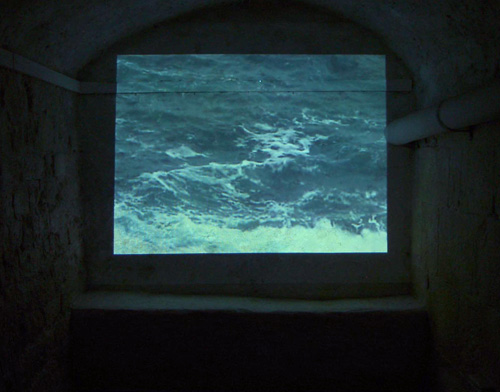|
Haptic Cinema Experiments Paola Valenti, 2005
|
 |
|
Scott
Hayes´ intervention in Studio44 Gallery is the result of a connection of
encounters: the
encounter
of a cosmopolitan artist – formed between Sydney, Paris and Vienna
– with the city of the Genova and the peculiar urbanistic tissue
of its historic centre; there, the encounter with the singular exhibition space, a true tunnel, obtained
from the coverage, centuries ago, of a „vicolo“ (lane) : an environment dense of history and perceptive
stimuli that, exactly because of these features, was for the artist
a starting point for conducting a reflection on the encounter between past and present,
between memory and contingency.
These thoughts, beyond being a fundamental reading key of Hayes´ work, have determined the methodology and the operational choices of his Genova intervention: Hayes has elaborated a basic concept for his installation out of the impressions of his first Genova stay, but has decided to subordinate the passage of the project stage to the operational stage in the moment in which, back in Genova to put up the show, he would have seen again the gallery and would have again walked in the maze of lanes and harbour streets: only then, by finding or not re-finding certain sensations, could he verify their authenticity and their real meaning. The
psychic and sensorial relationship between the artist and the place,
the re-actualization of past impressions, have therefore become conceptual
knots of the operation; an operation that – progressively –
has delineated an encounter between the concepts of space and perception. |
|
|
|
 |
|
|
|
|
|
The video, Unknownsomewhere,
realized specifically for the show; has represented for Hayes
an occasion to explore the haptic cinema, by examining the processes of
knowledge, of the relationship of space-perception, and of imagination:
in the haptic cinema the concepts of size, proportion, proximity, distance,
limit and horizon interlace and subvert each other, thus creating new
parameters for a different kind of seeing. Not by chance Hayes constructs
his video around images of the sea, that nomadic sea that Gilles Deleuze
opposes to the sedentary spaces and that he defines as a smooth space.
Smooth spaces are the sea, the desert, the
countryside; the city is a striate space; the countryside civilized
by agriculture, and the sea as scenario of navigation, are examples of
how the smooth space could become striate. In the striate space the lines
and the paths are subordinated to points: you go from one point to the
other, it is the space of the geographic maps. In the smooth space, on
the contrary, points emerge because a line passes through them: it is
the path that counts. In the smooth space, the line is a vector that constantly
changes its direction, like Foucault`s fool, or the nomad who´s trajectory
incessantly follows and chases a local vegetation, temporary, itself on
the move. (De Fiore). Thus the smooth space implies a different modality
of use, not supported by conventions, but uniquely depending on the sensorial
experience of the single individual, like the places and the images of
Scott Hayes´ haptic cinema.
|
